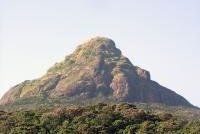
We visited 2 of the 3 elements of this site during a trip to Sri Lanka in 2005.
Horton Plains NP is particularly noted for its bird life including a number of Sri Lankan endemics and also harbours rare mammals. As such it appears on the itinerary of all Sri Lankan birding and wildlife tours. It reaches 2300m and consists of a mixture of forest and open grassland.
It can’t have been entirely coincidental that, just a few days before its consideration at Brasilia, a piece of news was released to the world’s newspapers to the effect that the Horton Plains Slender Loris had been photographed for the first ever time!! This is one of the World’s top 5 most endangered primates with possibly less than 100 remaining – a nicely timed piece of “news”!
Another piece of trivia which might be of interest is its very “English” title which relates to the British Governor of Ceylon 1831-7 - a Sir Robert Wilmot-Horton. He in turn had adopted the second part of his name under the terms of his father-in-law’s will which required that this action be taken in order that he could inherit the country estate!
Apart from the wildlife the main other “sights” within the Park are an 870m cliff known as “World’s End” and an attractive but not particularly noteworthy waterfall named “Baker’s Falls” after the British African explorer.
The second element we visited was the “Peak Wilderness Sanctuary” (which is adjacent to Horton Plains NP –the third element, the “Knuckles Range” is detached to the NW and is a bit lower). I note that this forest area has been inscribed solely on Natural criteria but the main reason most people will visit it is to pass through it when climbing “Adam’s Peak” which is situated within the inscribed area (photo). At 2243 m it is not in fact Sri Lanka’s highest mountain (though its shape and relatively isolated position makes it seem much more significant) but is a major site of pilgrimage because of the petrosomatoglyph near the summit in the form of a footprint variously assigned to Buddha, Shiva or Adam. The main route to the summit starts at Maskeliya and is heavily “engineered” with steps. In the pilgrimage season (Dec-May) the entire way is lined with stalls/ restaurants etc. Traditionally the climb is completed at night time to arrive in time for the sunrise which casts an enormous shadow of the mountain across the plains below. This was our reason for going there and, given the enormous throngs of people also doing the climb, we did not gather much feeling for the natural merits of the area we passed through!! Interestingly the pilgrimage route itself, including many other locations from various parts of the island, is on Sri Lanka’s T List in its own right as a cultural site. Furthermore Sri Lanka proposed this site on Natural, Cultural AND Cultural Landscape aspects - but the latter 2 were not accepted so Sri Lanka will have to put forward a different nomination to try to gain recognition for this aspect.
So, does the site deserve its inscription and is it worth visiting? The “Sri Lankan Montane Rain Forests” are regarded as constituting an eco-region in their own right and the WWF Web site states “These surveys demonstrate that this area's biodiversity is even more important globally than previously thought. The known levels of endemism apparently are only the tip of the iceberg. In light of the emerging information, the Sri Lanka Montane Rain Forests can be considered a super-hotspot within the endemism hotspot of global importance”. Sinharaja is already inscribed as an example of Sri Lankan Lowland Rain forest and IUCN has a “vision” by which all of the World’s eco-regions are represented by a WHS. It appears that IUCN actually recommended that these sites be added to Sinharaja to create a single site for Sri Lankan rain forest both lowland and montane. The result of the WHC's decision not to accept this recommendation is the inscription of a separate site which would seem to "grind" rather small as regards the eco-region it covers!
As for visiting them? Well Sri Lanka is not so large that it is a big problem to do so. However, unless you are particularly interested in spotting Sri Lankan endemic birds, Horton Plains will not repay a great deal in terms of “sights”. You may well enjoy escaping the heat of lower altitudes (and I suspect that is a major reason for its popularity among Sri Lankans!) and the views are pleasant enough, but not “spectacular” on a World comparability scale – even the famed “Worlds End”. Around these forest areas lie Sri Lanka’s main tea-producing regions and mountain resorts such as Nuwara Eliya. Indeed, whilst the British cut down the forest areas which today produce tea, they also enacted a policy in 1873(on the advice of Darwin’s friend, the botanist Hooker) which prevented the cutting down of any forest above 5000ft. If you are “doing” Sri Lanka you need to see this area and you might as well take in Horton Plains whilst you are there if you have the transport. As for climbing Adam’s Peak – well, it is an interesting aspect of Sri Lankan culture. Unless you are fit (which I wasn’t particularly!) it is a bit of a grind and the summit is so crowded that the sunrise shadow is quite difficult to see (unless you are a tall “Westerner”!) but, in retrospect, I regard the experience as worthwhile.
More on
Comments
No comments yet.
